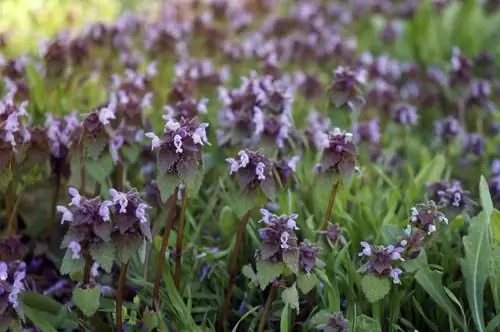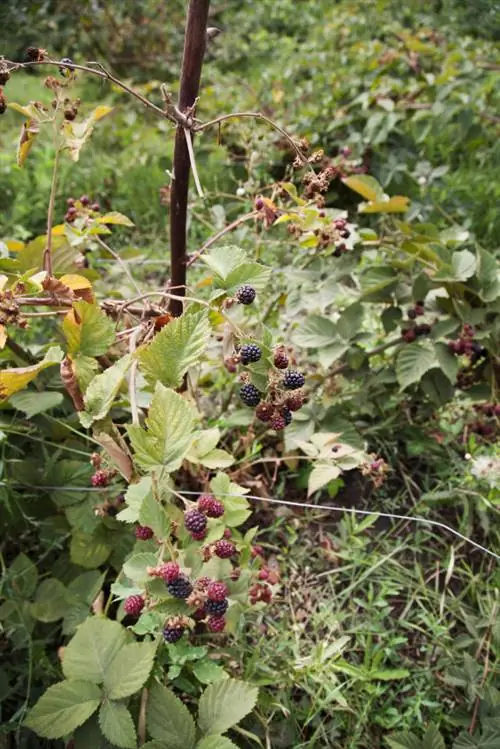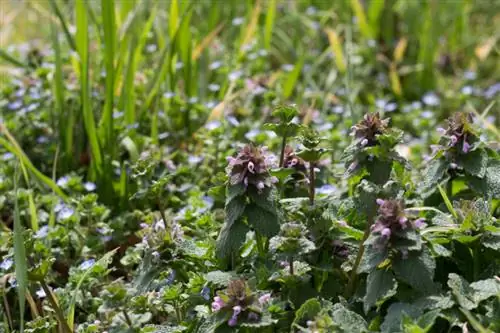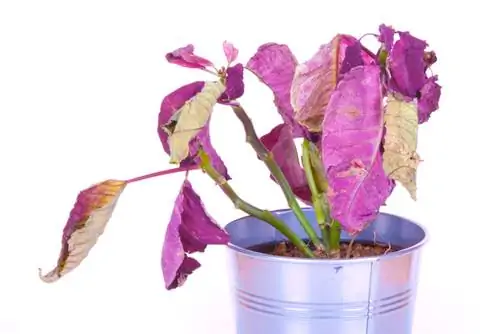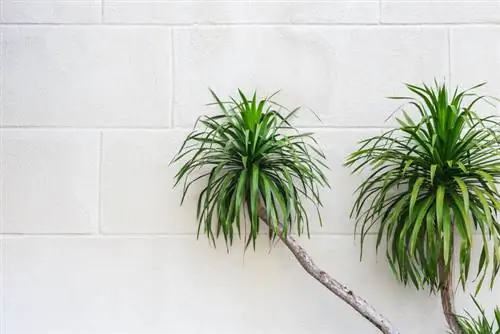- Author admin [email protected].
- Public 2023-12-16 16:46.
- Last modified 2025-01-23 11:22.
Gundermann is considered a weed by many hobby gardeners because it spreads unhindered and is difficult to remove. The dense carpets are difficult to remove without effort. Early action makes sense, but there are also alternatives to combating it.
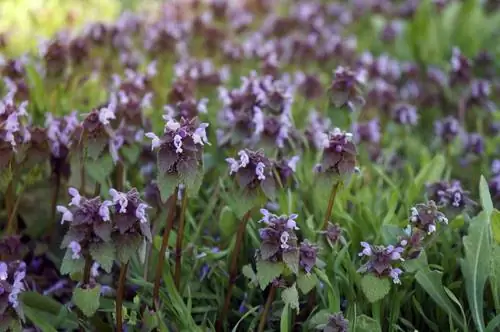
How to fight Gundermann in the lawn?
To effectively combat groundworm in the lawn, you should remove the mother plant by hand or with a weed cutter. Mowing and scarifying the lawn are not suitable measures as they can promote the spread. Walking on the lawn regularly helps limit plant spread.
Fight Gundermann
The Gundel vine is a shallow rooter and develops long runners that crawl on the ground and form side shoots every eight to 15 centimeters. These side shoots grow upright and produce flowers. The plant can spread thanks to the creeping shoot axes that root at many nodes. Under optimal site conditions, a main shoot can reach a length of up to two meters.
This is how the Gundermann overwinters:
- Plant is wintergreen
- Overwintering with two-leaf shoot parts
- Rosette leaves also overwinter
Remove manually
Due to the shallow root system, manual weeding is easy to do. If the soil is compacted, you can loosen the areas around a mother plant with a digging fork. However, depending on the spread of the plant, this measure can be very time-consuming. If sprout parts are overlooked and left behind, the plant can spread again. Therefore, a thorough approach is extremely important.
How to find the mother plant:
- Follow the trail to the origin
- Look for a strong plant with rosette leaves
- Find the main plant with numerous runners
Remove with weed cutter and hoe
Back-friendly tools are tools you can use to get the plant out of the ground. Weed killers are sometimes referred to as dock killers because they eliminate deep-rooted plants with relatively little effort. The devices are equipped with two metal tips that are inserted into the ground. The plants and their roots are then levered out of the ground. A weed killer works just as well for shallow-rooted plants like the Gundermann. In the bed you can tackle the unwanted plant with the hoe.
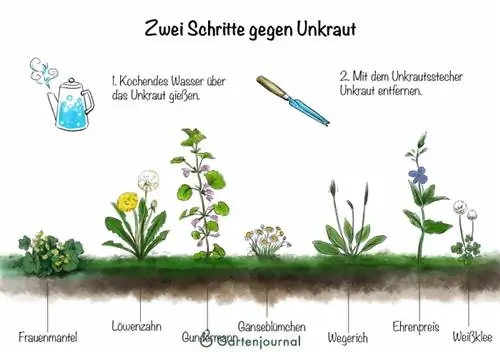
What you should avoid
If you take a closer look at the growth and ecology of the gundel vine, you will quickly be able to distinguish between senseless and suitable control measures. As soon as remnants of the runners remain on the lawn, the Gundermann can spread further.
Tip
Avoid special commercial products that are only intended to combat the Gundermann. Such products are usually ineffective and damage the lawn.
Cannot be destroyed by mowing the lawn
The chances of success in fighting the already well-established Gundermann with the lawnmower are rather low. This measure suppresses competing plants, so that the gundel vine definitely benefits from mowing. If the mother plant has not yet spread, it can be weakened by regular mowing. She is sensitive to regular access to the lawn. That's why the herbaceous plant prefers to grow in places that are mowed but not used for other purposes.
Excursus
A focal point of the Gundermanns
Commercial meadows are one of the main habitats of the gundel vine, because here there is a long-term good supply of water and nitrogen. The plant is particularly common in smooth oat meadows. It blooms together with meadow foamweed and dandelions, but also with other low-growing herbs. Outside of commercial meadows, the Gundermann is widespread on multi-cut lawns in gardens and parks.
Combat by scarifying senseless

No mowing or scarifying helps against Gundermann in the lawn
The term scarifying is made up of the terms “vertical” and “cut”. It could be translated as “cutting vertically”, because that is exactly what is done when scarifying. The rotating blades cut a few millimeters deep into the thatch. The knives usually do not reach the grass roots.
The measure is proving to be counterproductive in combating runner-forming weeds. The Gundermann's above-ground creeping shoots are also fragmented. However, these are even more difficult to remove from the surface afterwards. If leftover shoots remain, they continue to grow and form new mother plants.
Do not use chemical agents
There are chemical total weed killers with high effectiveness that also remove stubborn weeds. Such funds are often permitted for areas used for gardening. The plants must be completely wetted to ensure optimal absorption of the active ingredients. This means that cultivated plants also come into contact with the toxic substances. Such agents select between monocots and dicots, but not between unwanted and deliberately planted flowers.
Preventive measures
The Gundermann can only develop well under certain environmental factors. If there is enough sunlight, the plant forms numerous branches. If it is shaded, the plant reduces the development of branches. Instead, it invests the energy in the formation of leaf mass. In nutrient-rich soils, the fine roots develop more quickly and more numerously than in nutrient-poor substrates.
| Measure | Effect | |
|---|---|---|
| Lawn use | Increase pedal load | Disturbance |
| Fertilize | Avoid fertilization | Nutrient deprivation |
| Lawn cutting | remove after mowing | Nitrogen deprivation |
| Planting | sow competing flowering plants | Shading |
| Disposal | drying weeded plants on stone slabs before composting | Dehydration of seeds and roots |
Tip
Make sure the turf is thick, because the Gundermann has a hard time here.
Benefits of the Gundel vine
If the Gundermann has only spread to certain areas in the garden, it can increase the ornamental value and have a positive effect on biodiversity. The herbaceous plant does not cause any problems when spread out selectively, as a he althy and well-developed lawn can naturally keep the ground vine in check. You can also use the herb in the kitchen.
Important nectar plant
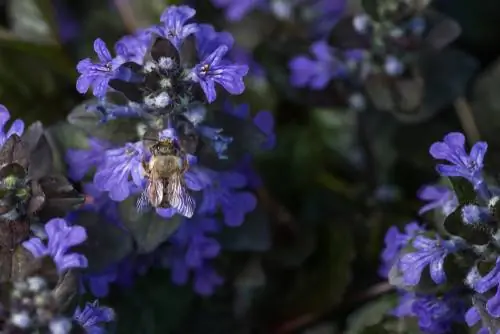
Gundermann is not a weed for everyone
Gundel vines bloom between April and July. This early flowering period makes them important sources of food. The herbaceous plants are an important source of nectar in spring when there are few flowers. Numerous insects fly to the flowers to ensure fertilization. In total, the Gundermann serves as a food source for around 30 different species.
Which insects fly to the Gundermann:
- Bees: Fur bees and bumblebees
- Dipterans: Hoverflies, Woolly Floaters
- Butterflies: Aurora butterfly, brimstone butterfly, green-veined white butterfly
Medicinal herb
The gundel vine has numerous areas of application in folk medicine. A tea helps against an upset stomach and loss of appetite, diarrhea and problems with the bile, liver and kidneys. The extract can be used to gargle for inflammation of the mouth and throat. Pastes are used externally to treat wounds.
Gundermann is said to have these effects:
- relieves coughs and respiratory problems
- Promotes wound healing when used externally
- has a slightly diuretic and astringent effect

Culinary herbs
The Gundermann is rich in bitter substances, tannins, vitamin C and minerals. Its leaves have a slightly sharp and bitter taste, which is why they should be dosed carefully. As a herb, the gundel vine refines pan-fried dishes such as fried potatoes or egg tarts. It can be used in game meat dishes or for wild herb salads, herb quark and herb butter.
Recipe for a summer salad:
- chop various wild herbs such as sorrel, chervil, yarrow, ground gunder and gourdweed
- Cut onion, garlic clove and chives into small pieces
- Mix herbal s alt with fruit vinegar, pumpkin seed oil and olive oil and refine with sour cream
- Pour sauce over salad and stir well
Pointer plant
The Gundel vine is a typical plant on soils with a good supply of nitrogen, calcium and phosphate. It grows mainly on heavy soils with a good water supply. The Gundermann is most commonly found on soils with a pH between 5.5 and 7.5. However, slightly acidic soils do not cause any problems for the herb. The plant cannot tolerate s alt.
Frequently asked questions
Where does the Gundermann occur?
The gundel vine is an indicator plant that indicates nitrogen-rich and fresh to moist soils. Although it relies on light, it can also hold its own against dense and tall growing competition from perennials. In order to make optimal use of the amount of light, the plant invests a lot of energy in the development of leaf mass. It also often grows taller in shady areas. The Gundermann is typical for commercial meadows and multi-cut lawns with a good supply of nutrients.
What helps against Gundermann in the lawn?
Gundermann is extremely resistant and can only be removed through thorough weeding. If remnants of shoot axes remain, new plants quickly form. Use a weed puller to get the mother plant out of the ground. Carefully pull the above-ground runners out of the lawn and make sure that no shoots break off. Regular foot traffic prevents the Gundermann from spreading further.
How was Gundermann seen in the past?
The times when the Gundel vine was said to have magical powers are long gone. As one of the nine Maundy Thursday herbs, Gundermann was supposed to protect against diseases all year round. Leaves were baked in plum cake batter for St. John's Day and added to beer as a spice.
Pets should also benefit from the positive properties. When chickens started brooding, a wreath of Gundermann was placed around the nest. This was supposed to protect against demons. By adding Gundermannkraut to cow feed, people hoped for better milk production.
Why is Gundermann not only a weed but also an ornamental plant?
If the soil moisture is sufficiently high and the soil is well supplied with nutrients, the Gundermann also thrives in shady conditions. Thanks to its long runners, it forms dense carpets that remain green even in winter. This property makes the herb a popular underplant in locations that are otherwise difficult to colonize with other flowering plants.
Are there any cultivated varieties of Gundermann?
While many hobby gardeners have to think about measures to combat groundworm, other nature lovers bring attractive cultivated forms of the plant into their garden. Varieties with two-tone foliage such as Glechoma hederacea 'Variegata' are particularly popular. They can be combined with various spring and summer flowers and embellish hanging baskets and flower boxes.

